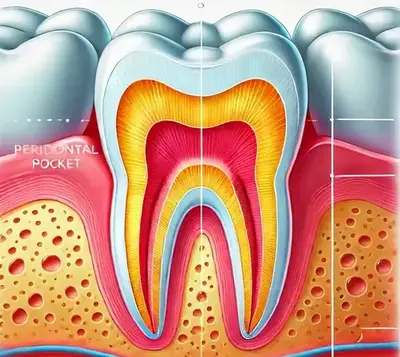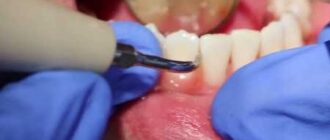When you think of oral health, it’s easy to focus on white, sparkling teeth as the ultimate goal. However, what lurks beneath the gumline tells a far more important story—one that could mean the difference between healthy gums and the risk of losing teeth. One of the biggest, yet often overlooked, indicators of oral health is the presence of periodontal pockets.
What Are Periodontal Pockets?
In simple terms, periodontal pockets are spaces that form between the teeth and gums when the gums pull away from the teeth. This gap serves as a home for harmful bacteria, leading to infection and further tissue breakdown. The deeper these pockets become, the harder they are to clean, and the greater the risk of gum disease progression and eventual tooth loss.
Healthy gums have pocket depths of 1-3 millimeters. When these depths exceed 4 millimeters, it’s an indication that something is wrong. Pockets of 5-7 millimeters signal moderate gum disease, while anything beyond 7 millimeters is considered severe and often requires surgical intervention.
The Numbers Don’t Lie: How Common Are They?
Periodontal pockets are more common than many realize. According to the Centers for Disease Control and Prevention (CDC), 47.2% of adults aged 30 years and older in the United States have some form of periodontal disease, which often includes the presence of periodontal pockets. Among adults over 65 years, this number jumps to 70.1%. These statistics underscore the importance of regular periodontal checkups as we age.
Dr. Richard Torres, a periodontist with 15 years of experience, shares, “Most people think they’ll never have to deal with gum disease, but the truth is, almost half of American adults do. And those periodontal pockets are a red flag that your gums are under attack.”
Why Do Periodontal Pockets Form? The Root Causes
Plaque Buildup: The number one cause of periodontal pockets is the buildup of plaque—a sticky, bacteria-laden film that coats your teeth. If plaque isn’t removed by regular brushing and flossing, it hardens into tartar. Tartar is impossible to remove with a toothbrush alone and requires professional dental cleanings to eliminate. As tartar accumulates, it irritates the gums, causing inflammation, which eventually leads to the formation of pockets.
Smoking: Studies show that smokers are twice as likely to develop periodontal pockets as non-smokers. Smoking reduces the blood flow to the gums, impairing healing and making them more vulnerable to infection.
Diabetes: Uncontrolled diabetes is another significant risk factor. The excess sugar in the blood provides a perfect environment for bacteria to thrive, increasing the likelihood of gum inflammation and pocket formation.
Genetics and Other Factors: Genetics, hormonal changes (like those occurring during pregnancy), and even certain medications that reduce saliva flow can all contribute to the formation of periodontal pockets. Understanding your own risk factors can help you be proactive about your oral health.
Periodontal Pockets and Daily Life: The Discomfort and Risks
The presence of periodontal pockets doesn’t just affect oral health; it can also impact your quality of life. Bleeding gums, persistent bad breath, and pain while eating are all common symptoms of deep periodontal pockets. A survey by the American Academy of Periodontology found that nearly 30% of people with periodontal disease reported embarrassment about their breath, often avoiding close contact or social situations.
But the risks go beyond bad breath. If left untreated, the bacteria in these pockets can lead to the destruction of the bone that supports the teeth, resulting in tooth loss. In fact, periodontal disease is the leading cause of tooth loss in adults.
Treatment Options: From Deep Cleaning to Surgery
Treating periodontal pockets depends on their depth and severity. Let’s explore some of the most common treatment methods:
| Treatment Method | Description | Average Cost (USD) |
|---|---|---|
| Scaling and Root Planing | Deep cleaning to remove plaque and tartar below the gumline. | $150 – $350 per quadrant |
| Antibiotic Therapy | Antibiotics applied directly to the pockets to reduce bacteria. | $50 – $100 per application |
| Laser Therapy | Lasers are used to remove infected tissue and promote healing. | $500 – $1,000 per session |
| Surgical Intervention | Flap surgery or bone grafting to reduce pocket depth. | $1,000 – $3,000 per procedure |
Scaling and Root Planing is often the first line of defense, especially for pockets measuring 4-6 millimeters. This procedure can be uncomfortable, but it’s crucial for removing the tartar that ordinary brushing can’t reach. Antibiotic therapy is often used in conjunction with scaling to help kill bacteria directly in the pocket, ensuring a more comprehensive treatment.
For deeper pockets (7mm and beyond), surgical intervention might be necessary. This could involve lifting the gums to remove tartar from deep below the surface, reshaping the bone, or even using bone grafts to replace lost tissue. Though surgery can sound intimidating, it is sometimes the best chance to save the teeth and halt the disease’s progression.
The Cost of Inaction
Ignoring periodontal pockets can have serious financial implications. On average, treating advanced periodontal disease, including tooth extraction and replacement with dental implants, can cost anywhere between $3,000 to $5,000 per tooth. Comparatively, the costs of preventative care—routine dental visits and professional cleanings—are far more manageable.
The American Dental Association emphasizes the importance of early intervention. “Gum disease is silent until it’s not,” says Dr. Michelle Nguyen, a preventive dentistry specialist. “By the time it hurts, you’re already in trouble. Early diagnosis and treatment save both your teeth and your wallet.”
Our Editorial Team’s Advice for Keeping Periodontal Pockets at Bay
If you’re concerned about periodontal pockets, the best thing you can do is take proactive steps now. Daily flossing is non-negotiable—it’s the most effective way to remove plaque from between the teeth and below the gumline. Regular professional cleanings (twice a year or more if recommended by your dentist) are critical for removing tartar that cannot be addressed at home.
If you notice bleeding gums, persistent bad breath, or sensitivity around your teeth, don’t ignore it. Visit your dentist or periodontist for an evaluation. Catching periodontal pockets early is key to preventing more serious interventions later on.
Remember, periodontal health is about more than just keeping your teeth—it’s about keeping your overall health in check. Studies have shown that gum disease is linked to cardiovascular issues, diabetes, and other systemic health problems. A little prevention goes a long way, and taking care of your gums today means a healthier tomorrow for your entire body.






